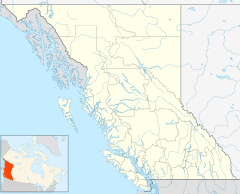Fort Shepherd, British Columbia facts for kids
Quick facts for kids
Fort Shepherd
|
|
|---|---|
| Country | |
| Province | BC/BCE |
Fort Shepherd is the site of a former Hudson's Bay Company fort in the West Kootenay region of southern British Columbia. The fort was on the west side of the Columbia River, across from the mouth of the Pend-d'Oreille River, southwest of Trail. Today, Fort Shepherd is known as a "ghost town" because the settlement is no longer active.
Contents
Fort Shepherd: A Historic Trading Post
Fort Shepherd was an important trading post built by the Hudson's Bay Company (HBC). The HBC was a powerful British company that played a huge role in Canadian history. They traded furs, especially beaver pelts, with Indigenous peoples. These furs were then sent to Europe to be made into hats and other goods.
What Was the Hudson's Bay Company?
The Hudson's Bay Company started in 1670. It was one of the oldest and largest trading companies in the world. They explored vast areas of North America, setting up trading posts like Fort Shepherd. These posts helped them collect furs and supply goods to traders and Indigenous communities.
Why Were Forts Like Shepherd Built?
Forts like Fort Shepherd were built for several reasons:
- Trading Hubs: They served as places where European traders and Indigenous peoples could meet. They exchanged furs for European goods like tools, blankets, and firearms.
- Supply Depots: Forts stored supplies needed for the fur trade. This included food, equipment, and items for trade.
- Strategic Locations: They were often built near rivers or lakes. These waterways were like highways for canoes and boats. Fort Shepherd's spot on the Columbia River was perfect for travel.
- Protection: Sometimes, forts offered protection for traders and their goods. They were often built with strong walls.
Trade and Travel
The location of Fort Shepherd was key. It was on the Columbia River, a major waterway for trade and travel. The nearby Pend Oreille River also brought traders from different areas. This made Fort Shepherd a busy place for a time.
Life at Fort Shepherd
Life at a fur trading fort was often tough. Traders, clerks, and laborers lived and worked there. They dealt with harsh weather, long journeys, and isolation. Indigenous families also visited the fort regularly for trade. They brought furs and shared their knowledge of the land.
The End of Fort Shepherd
Fort Shepherd was not active for a very long time. The fur trade began to decline as tastes changed in Europe. Also, new ways of transportation, like railways, made river travel less important. Many forts were abandoned as the company's focus shifted. Fort Shepherd became one of these "ghost towns." Today, only historical markers and remnants show where it once stood. It reminds us of a time when the fur trade shaped much of early Canadian history.


